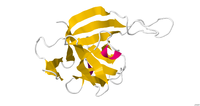
Photo from wikipedia
The interleukin (IL)‐36 cytokines include 3 agonists, IL‐36α, IL‐36β, and IL‐36γ that bind to a common receptor composed of IL‐36R and IL‐1RAcP to stimulate inflammatory responses. IL‐36Ra is a natural… Click to show full abstract
The interleukin (IL)‐36 cytokines include 3 agonists, IL‐36α, IL‐36β, and IL‐36γ that bind to a common receptor composed of IL‐36R and IL‐1RAcP to stimulate inflammatory responses. IL‐36Ra is a natural antagonist that binds to IL‐36R, but does not recruit the co‐receptor IL‐1RAcP and does not stimulate any intracellular responses. The IL‐36 cytokines are expressed predominantly by epithelial cells and act on a number of cells including immune cells, epithelial cells, and fibroblasts. Processing of the N‐terminus is required for full agonist or antagonist activity for all IL‐36 members. The role of IL‐36 has been extensively demonstrated in the skin where it can act on keratinocytes and immune cells to induce a robust inflammatory response that has been implicated in psoriatic disorders. Emerging data also suggest a role for this cytokine family in pulmonary and intestinal physiology and pathology.
Journal Title: Immunological Reviews
Year Published: 2018
Link to full text (if available)
Share on Social Media: Sign Up to like & get
recommendations!